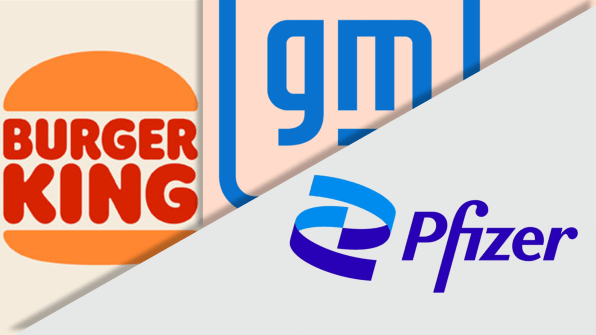
Companies are looking to rebrand in the aftermath of the pandemic. But they need to keep in mind a few key messaging guidelines.
BY DEBORAH SCHROEDER-SAULNIER
For the first time in more than 20 years, Burger King announced a brand-new logo, along with new packaging, uniforms, and signage. But Burger King isn’t the only big company unveiling a fresh new look this year. Other companies have already done the same. General Motors announced a new logo that highlights its commitment to electric vehicles. Kia is celebrating its best retail sales year ever in 2020—with a new logo. Pfizer, which created one of the COVID-19 vaccines with BioNTech, also did its most significant brand refresh in about 70 years.
As we start to see the light at the end of the pandemic, it’s likely that more companies will look to rebrand: acknowledging all of the damage that COVID-19 has caused and repositioning their brand for the post-pandemic future. But it’s important to be strategic about these moves and embrace a paradox of fresh and familiar in order to ensure the rebrand doesn’t further alienate customers.
WHY ALL THIS REBRANDING NOW?
According to an August 2020 article, McKinsey reports 75% of Americans have changed brands during the pandemic. The top three reasons are value, availability, and convenience. This means there’s major opportunity to attract new customers who may be shifting preferences after the lifestyle upheaval they’ve experienced over the past year. When the constraints of the pandemic are lifted, customers will go after what was previously out of their reach. A recent Harris Poll underscores this fact: There’s a lot of pent-up demand, and brands want to be able to cash in on this with a fresh face when it happens.

BUT CAN REBRANDING BACKFIRE?
When to rebrand and when not to is a hard lesson to learn. Too much change can be disastrous. A slight modification may miss the mark. In 2009, Tropicana removed the iconic Florida orange for a more modern one, then reverted back after sales dropped by 20% in just one month. Gap also made a change to its logo in 2010, attempting to reflect a more minimalist aesthetic. After immediate backlash, it very quickly switched back to its original logo design. As a company, it’s important to ask, what are the objectives of rebranding? Is this a chance to reposition, to create alignment and relevancy, or to simply communicate growth and innovation to the market? If a company is unable to clearly get its message across, its rebranding could hurt it.
Walking the thin line between “fresh start” and “steadfast reliability” is a business imperative. Fresh and familiar is a key paradox for businesses to leverage, and it’s not an easy one. Customers are looking for growing relevance in an ever-changing world, while also craving the stability of a trusted brand. Ford’s marketing is well known for its ability to rebrand successfully. Last year it leaned into nostalgia and invested in new technology with the relaunch of the Ford Bronco; now it masterfully plays on the theme of retro cool-meets-modern swag. In 2014, the Corvette Stingray launched with an ability to burn rubber and get 29 mpg . . . more powerful, yet more efficient.
HOW TO APPROACH A REBRAND
A May 2020 McKinsey article noted that “brands draw their power from three sources: science (insights generation and performance measurement), art (creativity), and craft (management and execution).” Robust brand foundations are especially important in times of accelerated change: deep understanding of customers and markets, creatively clear purpose, and focus on the brand experience. All must be delivered consistently to drive both brand perception and business performance.
- Revisit your current mission, vision, and values.
- Assess the “assumed” strength of your current brand—qualitative, quantitative, social media.
- Listen to your customer base (current and potential), the market, your competition, your changing environment.
- Think about what parts of your business need to stay stable and what needs to change.
- Be clear about the specific objective of your rebranding strategy: overcoming a crisis, new mission or vision for your business, market repositioning, merger/acquisition, new location, etc.
- Plan the redesign for stability and change/agility.
- Test with your customer base.
- Craft launch and communication with customer involvement.
Will we see some winners and losers in the rush to rebrand in 2021? Yes, of course. Not all rebrands are created equal. The companies who are able to leverage paradox thinking in the development of their new brand identity will create the kind of competitive advantage that enables companies to thrive.
